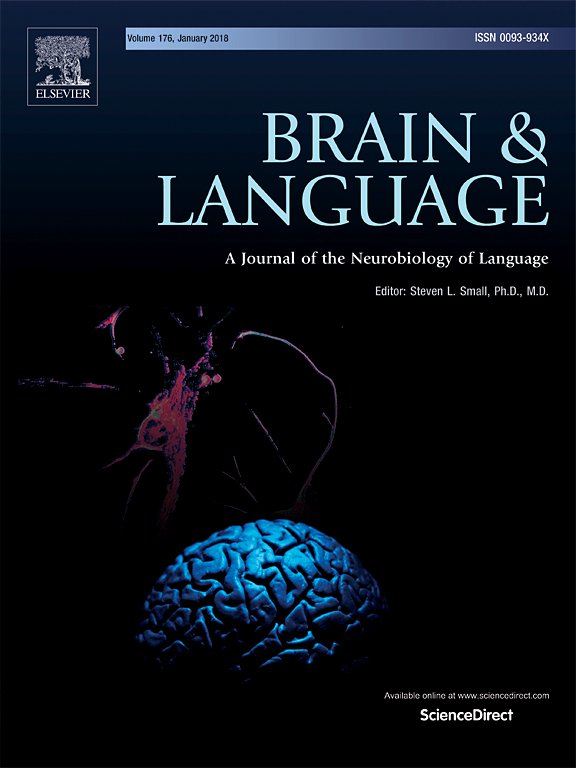Brain imaging of tongue-twister sentence comprehension: Twisting the tongue and the brain

- Introduction
The role of phonological processing in silent reading has been intensely debated
without respite for decades. Although there is little doubt that phonological representations
are important in learning to read (see e.g., Gathercole & Baddeley, 1993;
Johnston, Thompson, Gletcher-Flinn, & Holligan, 1995; Wagner & Torgeson, 1987),
the role of phonological processing in the skilled reading of adults remains an area of
controversy. Some researchers report evidence of prelexical activation of phonological
information (e.g., Lukatela & Turvey, 1990, 1994a, 1994b; Naish, 1980; Van
Orden, 1987; Van Orden, Pennington, & Stoner, 1990), while others find no such
effects (e.g., Seidenberg, Waters, Barnes, & Tanenhaus, 1984; Waters & Seidenberg,
1985; Waters, Seidenberg, & Bruck, 1984). Nevertheless, a role for phonologically
mediated access to semantics in skilled readers is accepted by both dual-route (e.g.,
Coltheart, Brent, Atkins, & Haller, 1993) and connectionist (e.g., Plaut, McClelland,
Seidenberg, & Patterson, 1996; Seidenberg & McClelland, 1989) models of lexical
access, although such models differ in terms of the situations, timing, and degree to
which such processes play a role. The current study brings the technique of functional
brain imaging to bear on the question of which psychological processes related
to phonology are affected during the silent reading of tongue-twister sentences.
The role of phonological processing in reading has usually been studied in the
context of recognizing single words rather than in the context of sentence comprehension.
One sentence paradigm that has been used to demonstrate such a role involves
the comparison of silent reading of ‘‘tongue-twisters,’’ sentences which contain
a large proportion of words that share the same initial phonemes, with those that do
not. Such sentences produce slower reading times for skilled readers, whether the
reading is silent or overt (Haber & Haber, 1982). This tongue-twister effect on reading
times is also found for the reading of extended texts for comprehension in both English
(Ayres, 1984) and in logographic writing systems such as Chinese (Zhang & Perfetti,
1993). Skilled readers are also slower and less accurate in verifying the semantic acceptability
of sentences that contain a large proportion of words that share the same
initial phoneme or that contain a mixture of words whose initial phonemes share the
same place of articulation (e.g. /b/ and /p/), but which differ in voicing (McCutchen,
Bell, France, & Perfetti, 1991; McCutchen & Perfetti, 1982). In addition, congenitally
deaf readers show comparable effects in semantic acceptability judgments (Hanson,
Goodell, & Perfetti, 1991), suggesting that the role of phonology in reading is not
simply a residual effect of learning to read with the support of auditory input. In
summary, the slowing of the reading process by phonological similarity suggests that
phonological or articulatory codes are being activated in normal reading.
Two main possible accounts of the tongue-twister effect have been suggested. One
account, articulatory based, is that the tongue-twister effect results from a bottleneck
in subvocal phonological/articulatory processing at a prelexical stage or in lexical
access (Haber & Haber, 1982). Such an articulatory locus could produce a deficit
in comprehension or memory maintenance by diverting cognitive resources
from comprehension or maintenance processes to the processing of phonological/
articulatory codes or to the repair of phonological errors. The second account,
memory-based, is that the difficulty of tongue-twister sentences results because the
phonological similarities interfere with the normal maintenance of the surface
structure of the sentence within a verbal working memory system (e.g., the articulatory
or phonological loop of Baddeley & Hitch, 1974) during syntactic and semantic
comprehension. Such interference might require reprocessing of the words in order
to obtain more complete information about the words (McCutchen & Perfetti, 1982)
or about their order in the sentence (McCutchen et al., 1991), adding to the processing
time. Both accounts enjoy empirical support, and they are not mutually
exclusive.
The evidence to support the articulatory account is not unequivocal. Attempts to
provide evidence of specific articulatory interference between reading tongue-twister
sentences and secondary tasks involving the same articulatory features in wordinitial
phonemes have been mixed. When participants overtly articulated phrases
involving repetition of the same place of articulation of the initial consonants concurrently
with silently reading tongue-twister sentences for a semantic acceptability
judgment, there was no evidence of an interaction between the place of articulation
for the phrase and for the sentence (McCutchen & Perfetti, 1982). On the other hand,
phoneme-specific interference occurred when participants silently maintained a sequence
of numbers that shared the same place of articulation as tongue-twister
sentences that were simultaneously read (McCutchen et al., 1991). In this latter